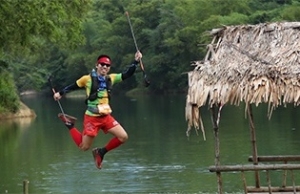Vietnam’s sports economy to lead a new era of development
How is Vietnam’s sports economy developing compared to the region and beyond?
Vietnam has seen a rapid surge in its sports economy, even achieving a higher annual growth rate than the global average. In recent years, various aspects of the sports business – including domestic and international ventures, production management, services, marketing, sponsorships, and the labour market – have developed steadily.
 |
| Nguyen Manh Hung, deputy director of the Social Affairs Department at the Central Economic Committee |
Several major global sports brands have chosen Vietnam as a key manufacturing hub, and significant foreign investment has provided a substantial boost to the production and consumption of sports equipment. Domestic enterprises have also actively participated in production processes, benefiting from exposure to modern management, production, and distribution cycles. As a result, the quality and design of products have improved significantly, meeting both domestic and export demands.
Vietnam’s rapidly growing economy and rising living standards are driving increasing demand for sports training, goods, and services. This trend is expected to further accelerate the growth of the country’s sports industry.
What does Vietnam need to do to enhance its competitiveness and the development of sports business services?
At this stage, Vietnam’s sports market is in the early stages of development, marked by rapid and diverse growth in goods and services. As the market evolves, it must adhere to market principles and align with broader economic development goals. This includes leveraging the market to attract capital and highly skilled labour, thereby enhancing competitiveness with other industries.
Vietnam’s Sports and Physical Training Development Plan with a vision to 2030 outlined steps to encourage joint ventures and partnerships between the state, businesses, and individuals for sports business development, both domestically and internationally. The sports economy is designed to support economic sectors in addressing societal challenges, and the development of goods and services must be tailored to the country’s geographical and social conditions, balancing business growth with environmental protection and social equity.
What is the current legal framework in Vietnam for the development of the sports economy?
While Vietnam’s Sports Law has introduced policies aimed at fostering the sports economy, it has yet to comprehensively address the business side of sports.
Further research and legal amendments are needed to promote sports business, especially following the issuance of a January directive regarding sports development in the new era. This directive underscores the need for a more robust legal framework to promote the sports market, including goods and services, and to foster public-private partnerships (PPPs).
Previously, the Sports and Physical Training Development Plan emphasised the importance of joint ventures and partnerships between the state, professional organisations, businesses, and individuals to develop the sports business. The plan identified key areas of focus to foster professional sports operations.
Firstly, there is a need to revise and supplement the Sports Law to better support sports business, introducing policies that encourage and facilitate market development. New legal provisions should focus on fostering professional sports businesses and promoting partnerships between the state, businesses, and individuals, both domestically and internationally.
Secondly, a strategy should be developed to create and grow a sports market that operates under market economy principles, helping establish a more sustainable and competitive sports industry.
Thirdly, strengthening the legal framework around PPPs in the sports economy is crucial. Pilot projects should be launched in key national sports facilities under this model. Policies must encourage private sector participation in the construction, operation, and management of state-invested sports facilities, with local governments encouraged to implement innovative solutions in these efforts.
 | Building local brands via sports tourism Ba Ria-Vung Tau, with its 300 km of coastline and over 150 km of picturesque beaches, is not only a critical hub for energy, industry, and maritime trade in Vietnam but also an attractive destination for tourism. |
What the stars mean:
★ Poor ★ ★ Promising ★★★ Good ★★★★ Very good ★★★★★ Exceptional
 Tag:
Tag:
Related Contents
Latest News
More News
- Vibrant Vietnamese cuisine fit for global tastes (June 09, 2025 | 10:42)
- Vietnam can be global hot spot in 2025 (January 29, 2025 | 00:38)
- Promoting tourism and hospitality with sustainability (January 28, 2025 | 09:00)
- Vietnam centres on eco-luxury tourism and hospitality (January 28, 2025 | 02:06)
- Growth prospects for Vietnam’s event tourism in 2025 (January 28, 2025 | 01:18)
- Core values drive success at Marriott (January 24, 2025 | 16:00)
- Hoteliers to prioritise eco-luxury (January 04, 2025 | 09:00)
- Vietnam upscale tourism on the rise for 2025 (December 30, 2024 | 12:03)
- Addressing concerns can shape green hospitality (December 04, 2024 | 10:24)
- Vietnam boosting efforts to entice international tourists (October 08, 2024 | 11:47)






















 Mobile Version
Mobile Version